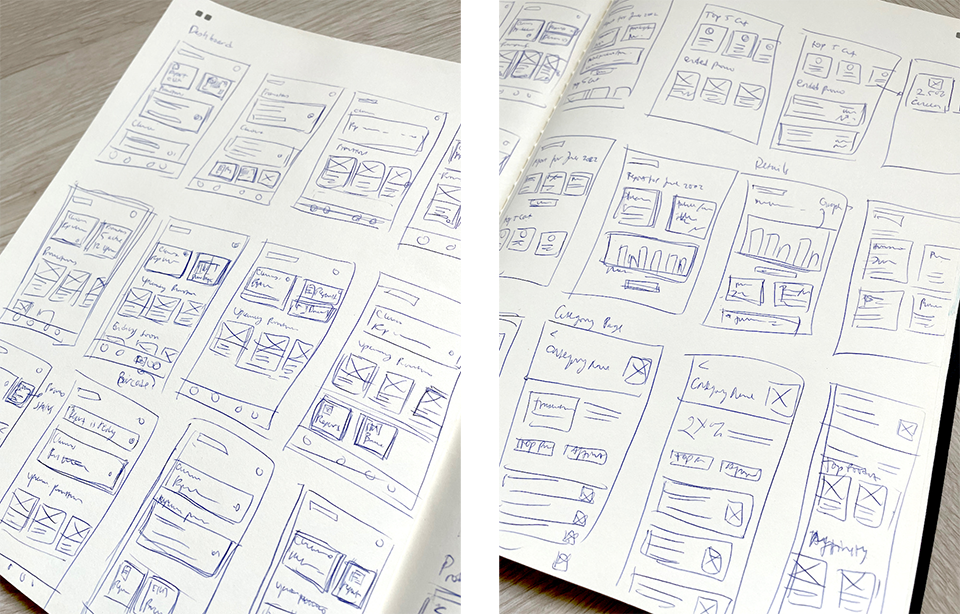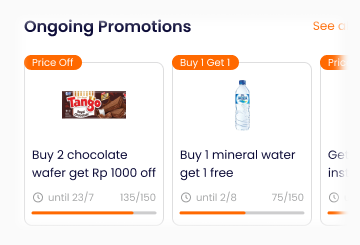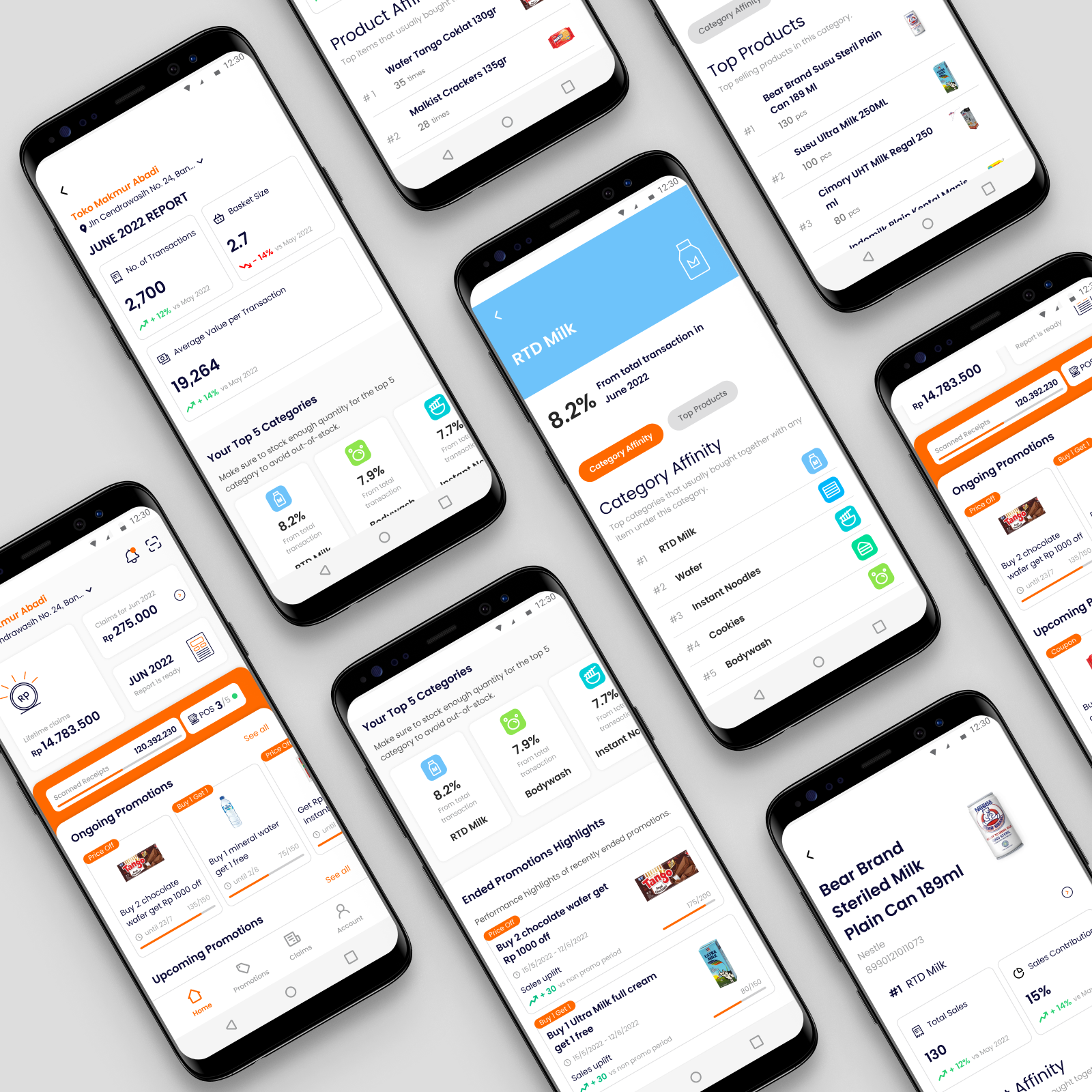
Merchant App Redesign
Empowering store owners with advanced insights.
The eyos Connect merchant app is created for store owners and managers who may not be present to manage the Point of Sale (POS) system. Users can view ongoing, upcoming, and expiring promotions, track their claims, and update their payment details using this app. Our goal is to improve user engagement by introducing new features that will provide insights into their store's performance, empowering them to make informed decisions to increase sales.
The Challenge
The app had a low adoption rate and active users since it only showed promotions and claims available in store tills. We wanted to add a new feature to the merchant app that can benefit the store owners, so we can increase the active users.
How might we make the merchant app to be more insightful for the store owners so they can make a data-driven decision to increase their store performance?

The old merchant app.
My Role
Working alongside the Product Manager, data science team and designer, my responsibilities were:
Lead the product discovery.
Set the product direction.
Create the user flow.
Design the mockups together with my designer.
DISCOVERY
Opportunity Solutions Tree (OST)
During the discovery phase, we reviewed the Opportunity Solutions Tree (OST) created earlier. We wanted to add a store report feature to the merchant app a year ago, but it was put on hold due to a major issue. The store report was designed and developed in a staging environment but was discontinued due to significant data discrepancies. We are now revisiting the feature to find ways to make it work effectively.
Data discrepancies are a long-standing blocker.
During our previous pilot, generating store reports posed a significant challenge due to data discrepancies between the merchant app and the store's POS. We've identified several causes for this issue:
Parsing errors.
Delayed receipts caused by unstable connections or offline POS.
Incomplete sales data due to some stores not installing eyos prism in every POS system.
eyos prism did not capture refunds, which affected the accuracy of transaction data.
Addressing this long-standing blocker is crucial to generating accurate store reports.

User Research
Based on our user research, we have discovered some insightful information from store owners and managers regarding their use of reports and how we can enhance their experience. Here are some of the key findings we collected during our interviews:
Some stores have already implemented reports from their POS system, but these reports are limited to sales and transaction data with no advanced analytics.
Smaller stores lack data literacy and do not read reports, focusing solely on profit and loss.
They do not require real-time reports and only read a daily consolidated report after store closure and at the end of the month.
They are aware of which products or categories sell well from the POS reports but are uncertain how to improve sales.
They desire the ability to compare their store's performance with that of their competitors.
They are interested in knowing which products or categories shoppers usually buy together (product/category affinity) to bundle them together or place them side by side.
They are unsure if eyos connect promotions are effective in increasing sales since no reports are available.
DEFINE
Product Requirements
After conducting research and reviewing the previous report design, we have identified several product requirements:
We aim to improve promotions and claims to enhance the user experience.
We will introduce a new store report that will not be real-time to avoid data discrepancies and will be provided on a monthly basis for the initial release.
The report will focus on the number of transactions rather than the value of transactions.
More advanced reports, such as category insights, will be provided to avoid redundancy with reports from POS systems.
We will provide store owners with more transparency on promotion performance after the promotion ends.
DEVELOP
Information Architecture
We revamped the IA entirely to accommodate the new features, including the store report, category and product insights.

Sketches & Wireframes
In the early stages, we were considering to include a trend chart for the report but dropped the idea to avoid the same mistake in handling the data discrepancies issue and the potential for misinterpretation.

DELIVER
Home Screen
We implemented an updated user interface to enhance the user experience. The home screen now provides more information related to promotions and claims, as well as a new button to access reports.


Lifetime Claims
This section shows the total benefits that the user has received since joining.

Scan Rate and Live POS Status
The scan rate is important for new stores to qualify for promotions, as they need to achieve a certain threshold of good receipt scanning. The live POS status displays the current active POS to ensure accurate data capture.

Ongoing and Upcoming Promotions
The new design displays more items on the home screen, eliminating the need for users to visit the promotions page for an overview. Additionally, users can now view ongoing promotions directly from the home screen.
Store Report
The report furnishes the user with data on the basket size and average value per transaction, which is typically unavailable from the POS system.
Moreover, the user can obtain insights on the top five categories and delve further into category insights. This comprises information on the category's contribution to the total transaction, category affinity, and top products within the category. To view detailed insights on an individual product level, the user can click on a specific product.

Store report flow.
KEY TAKEAWAYS
Regular user research is crucial to uncover significant facts from the user's point of view.
It's important to remember that less is more, as discovered when attempting to create a store report. After consulting with store owners, it was realised that they only need to view the report occasionally. We don’t have to make it more complicated than what they need.
Being open to new ideas is always advisable, as it was discovered during development that the product page could be a valuable addition to providing insights at the product level.

